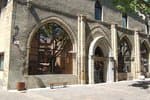The Grand Pastre
8 points of interest
 Flora
FloraMountain cornflower
This species is also known as Centaurea montana. The flowers of the mountain cornflower are melliferous, attracting butterflies and bees. This plant needs cool, moist soil to grow, whence its presence in the Clot la Saume forest. The cut foliage is green and woolly. Vernacular heritage
Vernacular heritageTraditional houses
Traditional houses in the Alps are often built into the slope. This can be explained by the desire to preserve the most easily cultivated land. The location of dwellings must also consider the proximity of water, while ensuring sufficient distance from mountain hazards (flooding, avalanches, landslides, etc.). These houses are generally arranged on three levels. The ground floor houses the stable for the herd and the farmyard. The heat given off by the animals benefits the whole house as it rises. This floor is sometimes also used to store farm tools. The first floor, accessed by a wooden staircase or balcony, is used for living space. Finally, the second floor is occupied by the barn, which is used to store grain and fodder for a whole year.
. Know-how
Know-howRetaining walls
The retaining walls are made of dry stone. They are called restanques in Provence. In steep areas, they can be used to create farmed terraces by retaining the soil. At the time, their construction enabled generations of farmers to make a living from their land, which became fertile and arable. Today, many researchers and craftsmen are trying to bring back this age-old technique. Fauna
FaunaThe Common Blue
In this small butterfly, the male's upper wings are dark grey, somewhat bluer at the base of the wings, while the female is brown. It is most often seen at higher altitudes, in July and August, in grasslands and meadows. The Arctic blue is a species of northern regions (Scandinavia, Greenland, Siberia, North America) which, in more temperate parts, lives only in the mountains. Pastoralism
PastoralismGrazing
Pastoralism is an extensive management technique. Known as the "Vachaïre", it emerged alongside cattle rearing and milk production. It entailed setting up a community-based herd management system, with the animals grazing every day. And it was the shepherd, "Lou Pastre" in Provençal, who was entrusted with managing the flocks.
 Pastoralism
PastoralismThe pastre
This is the Provençal word for shepherd. The trail got its name because of its many traces of pastoral activity along the way. Among other things, you can see the remains of ancient shelters known as muandes. These were used as stopovers between the farm and the mountain pastures during the transhumance up to the summer pastures at the start of the summer and during the transhumance to lower pastures in the autumn.
. Architecture
ArchitectureChurch of Marie-Madeleine in Les Orres
Characteristic of Hautes-Alpes architecture, it was built around 1501 and is remarkable for its size and painted decorations. Vernacular heritage
Vernacular heritageWash-houses
They can be found in almost every hamlet in Les Orres, but their purpose is no longer purely ornamental. Although the mid-twentieth century saw a decline in their use, they were once an essential place for socialising, as women used to gather there to do their washing. The Bua, the great bi-annual wash, thus took several days and followed a very precise ritual that culminated in the arduous operations of rinsing and drying.
.
Description
- Departure : Ski resort of Les Orres
- Arrival : Ski resort of Les Orres
- Towns crossed : Les Orres
Altimetric profile
Information desks
Tourist office Embrun
Place Général Dosse - BP 49, 05202 Embrun
October to march : Monday to Saturday, 9.00 - 12.30 & 13.30 - 17.00.
April, may, june & september : Monday to Saturday, 9.00 - 12.30 & 14.30 - 18.00
July and August : Monday to Saturday, 9.00 - 19.00. Sundays, 10.00 - 12.30 & 16.00 - 19.00
On French national holidays (except 14th of July and 15th of August) : 9am to 1pm. Closed on the 1st of January, 1st of May, 25th December and 11th November
Closed on Thursdays outside French holidays’ periods
Transport
Public transport: www.pacamobilite.fr
Consider car-sharing: www.blablacar.fr
Access and parking
Parking :
More information
Source

Report a problem or an error
If you have found an error on this page or if you have noticed any problems during your hike, please report them to us here:

